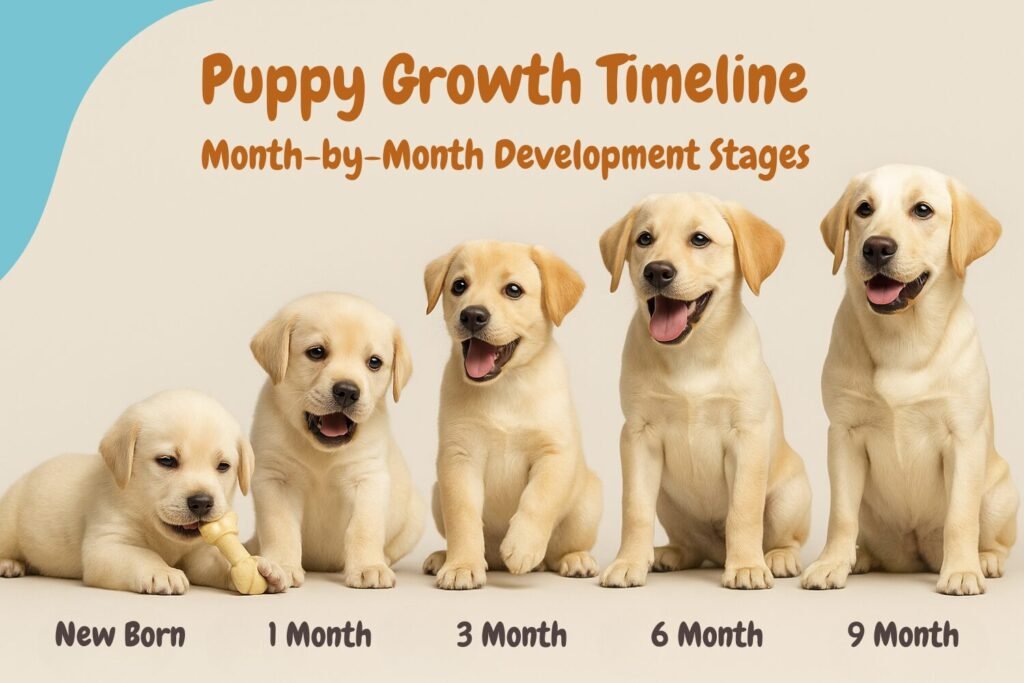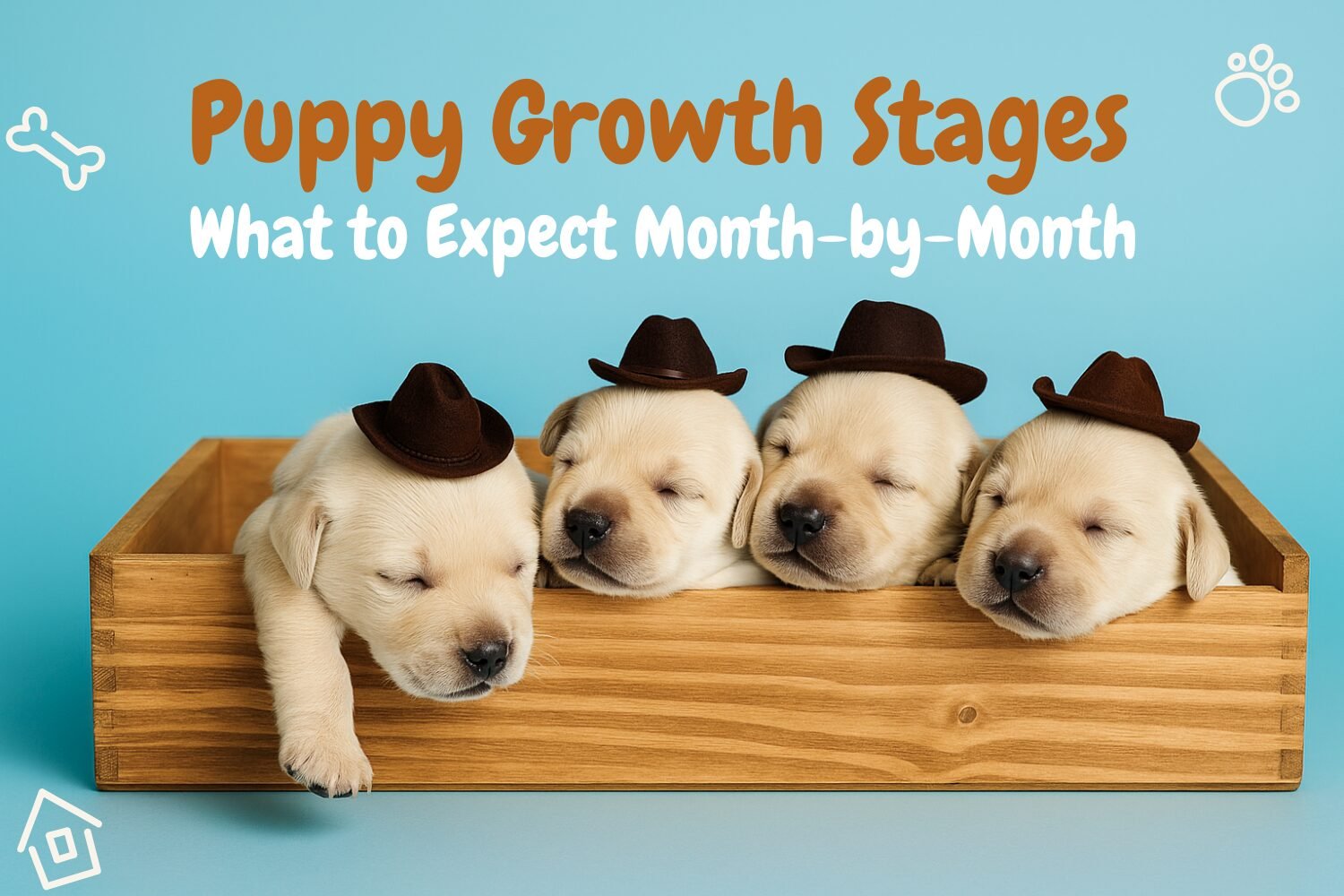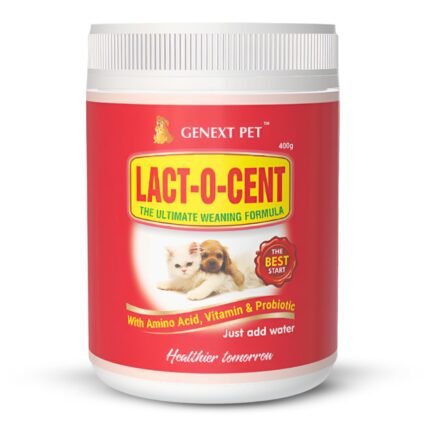Welcoming a new puppy into your life is a joyful (and sometimes chaotic) adventure. But did you know that your puppy’s first year is full of rapid physical, emotional, and nutritional changes? From tiny paws to teenage tantrums, each month brings new milestones.
In this guide, we’ll walk you through your pup’s growth stages month by month, covering key developmental markers, behavior changes, and nutrition tips to help you raise a healthy, happy dog.
Quick Glance: Puppy Development Month-by-Month

| Age | Key Milestones | Health & Nutrition Tips |
| 0–2 Weeks | Blind, deaf, nursing, sleeps 90% of the time | Mother’s milk only |
| 3–4 Weeks | Eyes/ears open, starts walking | Begin weaning with a milk replacer like Lact-O-Cent |
| 1–2 Months | Teething and socialization begin | Soft food + digestive care |
| 2–3 Months | Basic training, more alert & active | Core vaccinations begin |
| 3–6 Months | Fast growth, teething ends | High-protein food + calcium support |
| 6–12 Months | Puberty phase, behavior changes | Balanced nutrition, monitor weight |
| 12+ Months | Transition to adulthood | Shift to adult food, vet check-up |
Why Tracking Puppy Growth Matters
Understanding how your puppy grows helps you:
- Provide the right food & supplements at the right time
- Avoid common issues like malnutrition or underdevelopment
- Set the foundation for long-term immunity and bone health
- Identify early warning signs that may need vet attention
Month-by-Month Puppy Growth Stages
0–2 Weeks: Newborn Stage
- Completely dependent on the mother
- Eyes and ears are closed
- Should not be separated from the litter
Tip: No supplements unless prescribed by your vet.
3–4 Weeks: Weaning Begins
- Teeth start to erupt
- First attempts at walking
- Can begin weaning with puppy milk replacers like Lact-O-Cent
Lact-O-Cent supports gut flora, early immunity, and a smoother transition to solids.
1–2 Months: Social Pup
- Interacts more with littermates and humans
- Introduced to soft puppy food
- Start basic potty training and leash introduction
Watch for signs of diarrhea during food transitions. Probiotics like Neobiotic DFM may help.
2–3 Months: Training & Vaccinations
- First round of vaccines due
- Biting and chewing increase
- Energy levels shoot up
Ensure meals have balanced calcium and protein for muscle + bone growth.
3–6 Months: Growth Spurt Stage
- Larger breeds grow rapidly
- Baby teeth fall out, adult teeth appear
- Stronger need for calcium, magnesium, and zinc
For big breeds or active pups, bone support like GenextPet CAL helps strengthen joints early.
6–12 Months: Teenage Phase
- Sexual maturity in some breeds
- Behavioral challenges may start (chewing, barking)
- Appetite may vary based on breed
Check weight, vet visits, and adjust food quantity monthly.
12+ Months: Adult Transition
- Growth slows down
- Switch to adult dog food gradually
- Monitor joints and immunity as activity changes
To support immunity, Neocleotide helps build defense naturally.

Nutrition & Supplements That Support Puppy Growth
Here’s how to meet key needs in each stage:
| Need | Solution |
| Weaning Support | Lact-O-Cent with amino acids + probiotics |
| Digestive Care | Neobiotic DFM probiotic + enzyme blend |
| Immunity Boost | Neocleotide with nucleotides + S. boulardii |
| Bone Health | GenextPet CAL (Calcium + D3 + Zinc) |
Always consult your vet before starting new supplements.
Common Puppy Parenting Mistakes to Avoid

- Feeding adult food too early
- Skipping socialization during 2–4 months
- Over-supplementing without consulting a vet
- No parasite control in the first 3 months
- Assuming all breeds grow the same
When to Call the Vet
- No weight gain or stunted growth
- Chronic diarrhea or vomiting
- Unusual aggression or lethargy
- Delayed teething or poor appetite
- Limping, swelling, or odd posture
Final Thoughts
Your puppy’s first year sets the tone for their entire life. By understanding what to expect each month and adjusting their nutrition, training, and care, you’ll raise a stronger, smarter, healthier adult dog.
Looking for expert-formulated supplements for puppies?
FAQ
When does a puppy grow the fastest?
Most puppies, giant breeds, grow the fastest between 3 and 6 months of age. This stage needs high-protein food and joint support.
What should I feed my puppy during weaning?
Start with a high-quality puppy milk replacer like Lact-O-Cent, then gradually introduce soft puppy food over 7–10 days.
Is calcium necessary for growing puppies?
Yes, especially in medium to large breeds. Calcium helps support bone development and prevent issues like rickets or limb deformities.
How do I know if my puppy is underweight?
Visible ribs, low energy, and slow growth may indicate undernourishment. A vet check and dietary boost may be necessary.
Can supplements help with puppy immunity?
Supplements like Neocleotide with nucleotides, MOS, and probiotics help boost early immune defense during vaccinations and growth phases.
When should I switch from puppy to adult food?
Typically between 12 and 15 months. Smaller breeds may switch earlier, while larger breeds may need puppy food longer for full skeletal development.
About Author
Dr. Kevin Modi
Dr. Kevin Modi is a trusted voice in the Indian pet care space, with years of hands-on experience in pet wellness, gut health, and natural supplements. At GenextPet, he guides product formulation and ensures content accuracy, drawing from real-world insights and the latest research. His goal? To simplify pet health for every dog and cat parent.


